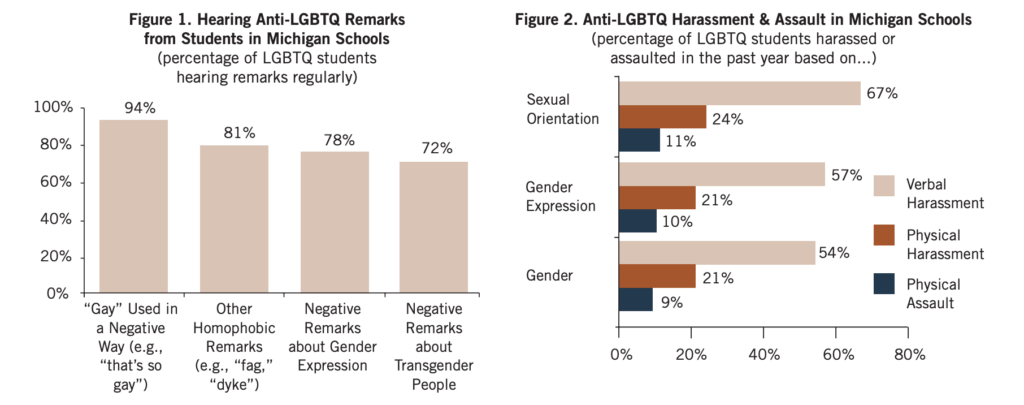
Usually on this blog, I share my expertise around PBL and SEL from my personal experience. This post will use some personal stories, but LGBTQ+ is an area of growth for me and I am in no way an expert on the topic. I feel it is important to share my journey and point toward others who are experts because we don’t talk about LGBTQ+ issues enough in education. And these issues are 100% Social and Emotional Learning in the areas of Self and Social Awareness.
This year I have been attending a series of virtual workshops from the Michigan Department of Education supporting LGBTQ+ students in our schools. We had a panel of LGBTQ+ students from around the state share their experiences with us. This past week we had as our guest Owen Bondono, the 2020-21 Michigan Teacher of the Year, who led us through some resources and answered questions. Owen is the first trans teacher of the year in our state. So in “old school” blogging style, here are some reflections on what I am learning.
Harassment of LGBTQ+ Students
I grew up in a conservative, religious, rural community. Most people that I knew opposed LGBTQ+ people for religious reasons. Most LGBTQ+ people were not “out” but everyone knew who they were. We were often judgmental, but mostly we pretended like LGBTQ+ didn’t exist in our community.
Nationally around 13% of students are LGBTQ+. So as Owen said in our workshop, “Unless you have a magical class with less than 10 students, then you have LGBTQ+ students.” Based on current surveys in Michigan (and I sincerely doubt the numbers are much different where you live), LGBTQ+ students are huge targets of bullying, harassment, and assault in schools. Unfortunately this includes teachers as the perpetrators. This is not ok. I don’t care what your personal beliefs are; we cannot tolerate prejudice and hate from students or adults in our schools toward LGBTQ+ students. We have professional and legal obligations to make schools inclusive and safe for all students.

A Culture of Safety and Belonging
I was a founding teacher at a comprehensive Project Based Learning school that functioned as a lab school for the county. We bused in kids from 20 districts representing urban, rural, and suburban communities. It did not take long to realize that we had a high percentage of LGBTQ+ students at our school. They were not recruited, but I think we gained a reputation as being an accepting, safe space for all students. We were by no means perfect. We definitely had students who were homophobic and transphobic, but our culture was inclusive and did not tolerate hateful speech. Based on the conservative communities that our LGBTQ+ students lived in, I can surmise that they did not feel as safe at their home districts.
In the fall of 2012, students completed the #MyParty election project where they created their own political parties based on issues that mattered most to them. Since my students came from such diverse areas across the county, we had all kinds of party platforms advocating for and against pretty much any issue imaginable. But one issue that stood out was gay marriage (not legal in our state at that time). No matter if the students were conservative, moderate, or liberal on other issues, they agreed in marriage equality. Students who personally opposed homosexuality for religious reasons still supported LGBTQ+ rights for marriage equality.
For the culmination of the project, we invited in a group of local state representatives. They were almost entirely Republican, because that is the voting demographic of our area. The students played 30 second commercials for their party and gave two minute stump speeches. When it was over the Representatives rushed me and only wanted to know one thing: Are all young people really this supportive of gay rights? They were literally in shock hearing this from the kids in their communities. You better believe that I told my students this story the next day! This is the power of student voice in action, influencing the leaders of our state.
Pronouns
I learned a ton about LGBTQ+ issues from my students. One day that stands out is when Cam, who identified as non-gender, informed me that their preferred pronouns were “they/them.” I had never heard of this before, and my initial reaction was thinking that it was really strange and made no sense because everyone knows those are plural. I did some research and began to learn more about different LGBTQ+ terms. I am thankful for Cam’s bravery to teach me about what mattered to them.
More recently it has become common for people to identify their preferred pronouns in certain situations including email signatures and social media descriptions. To be honest, I have resisted this trend, judging it as performative. But what I have learned the past few weeks, is that it can be powerful for LGBTQ+ students to know that teachers are allies to them. Currently as a teacher in a virtual school that has LGBTQ+ students (some identified and I assume many others who are not), I have struggled with how to show support for them. That’s when I realized that by including my pronouns in my communication, it’s a small signal to LGBTQ+ students that I respect their right to choose their pronouns. So I have made this subtle change, but it is too soon to report any student feedback yet.
Again, Social and Emotional Learning includes students having Self-Awareness of who they are and Social Awareness to accept those around them with different viewpoints. So what can we do as educators to make sure that our schools and classrooms are safe for all students, especially LGBTQ+ ones? Some basic things that everyone can do:
- Use students’ preferred names, regardless of whether or not it is their birth or legal name.
- Use students’ preferred pronouns, regardless of whether or not it makes you uncomfortable.
- Include literature that represents LGBTQ+ characters in your school and classroom libraries.
- Zero tolerance of homophobic or other discriminatory language or actions toward LGBTQ+ students, including from adults. (this is a legal responsibility)
Resources
As I stated above, there are many out there who are more educated than me on this topic and you should learn from them.
